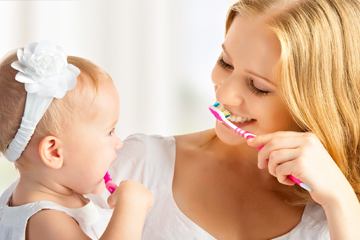
Usually, tooth decay and gum diseases are caused mainly due to a sticky substance that forms on your teeth called Plaque. When this substance stays on your teeth too long, it can lead to tooth decay and gum disease. Proper and regular brushing and flossing can help get plaque off your teeth and keep your mouth healthy.
With proper care, your teeth and gums can stay healthy throughout your life. Here are 12 best practices for healthy oral care:
- Brush your teeth at least twice a day with a fluoridated toothpaste. Fluoride helps harden tooth enamel and reduces risk of decay.
- Try to brush after every meal. Wait 30 minutes after eating before brushing, because this will allow any enamel that softened from acid during eating to re-harden and not get brushed away.
- Brushing teeth should at least take 2 to 3 minutes. Choose a toothbrush with a small head for better access to back teeth. Also give your tongue a few gentle brush strokes, brushing from the back of your tongue forward to remove bacteria – this freshens breath.
- Try to use soft bristles, as they are kinder on your gums.Remember to change your toothbrush with a new one every 3 to 4 months to avoid spread of bacteria.
- Rinse your mouth with an antiseptic mouthwash at least once a day to kill bacteria that cause plaque and early gum disease. Use a fluoride rinse as it can help prevent teeth decay and cavities.
- Another important practice in oral care is flossing. It can remove plaque and bacteria from between the teeth, where a toothbrush is unable to reach. It can also help prevent bad breath by removing debris and food that has become trapped between the teeth (www.medicalnewstoday.com).
- Cut back on dark drinks such as coffee, cola, black tea or red wine and other acidic foods, because these drinks or foods can cause teeth stains and color changes. Food acids soften tooth material and dissolve the minerals in tooth enamel, causing cavities. So keep an eye on your eating habits.
- Minimize the intake of candies and caramel sweets that stimulate the growth of bacteria in the mouth.
- Quit smoke or chewing tobacco.
- Protect your teeth from injury by wearing a mouthguard or full-face helmet when playing sports.
- Avoid using your teeth to crack nuts, remove bottle tops or rip open packaging, because such practices can cause chipping and even breakage.
- Get your routine dental check up and cleaning. This will tell if you have any dental or oral condition and help you get timely treatment. You should also visit your dentist if you have a dental problem such as a toothache or bleeding gums.
Practicing good dental care from childhood to later life is important to keep teeth and gums healthy. Along with regular brushing and flossing, maintaining a healthy diet can also help prevent cavities, gum disease, and other dental issues. Include calcium-rich food, such as dairy products and high-fiber vegetables, to keep your teeth strong and healthy.